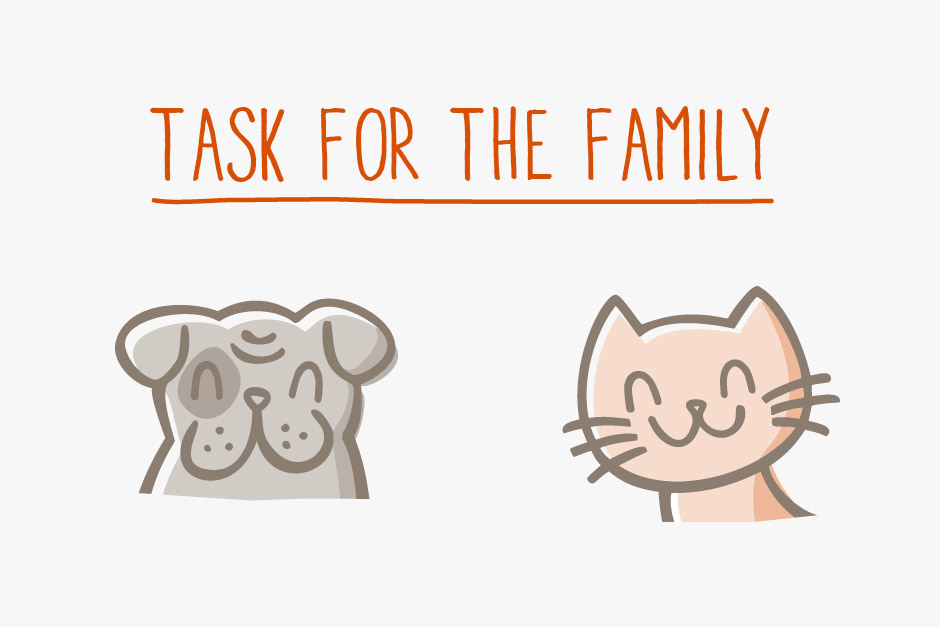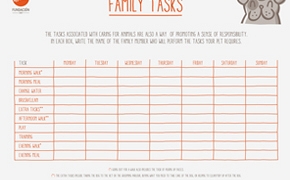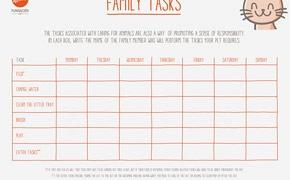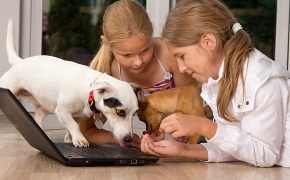How do you share out the tasks of caring for a family pet?

Many parents adopt a pet after giving in to pressure from children and their promises to take care of the animal. However, the reality is often different: children soon forget their promises and spend their time playing with the pet while the responsibility for caring for it falls almost entirely on their parents’ shoulders.
The fact is that, in themselves, pets don’t make children more responsible. However, sharing out the tasks associated with caring for your pet is an important educational tool that can help develop a sense of responsibility in the child, improving their patience and self-esteem and helping them understand and respect the fact that other individuals also need to be fed, cared for and loved.
Tasks by age
So children should be involved in caring for pets, but from what age? And in which tasks? Some children mature more quickly than others, but generally speaking:
Up to the age of 3, children will not distinguish pets from toys. At this age, children will not take part in caring for pets, but parents can start trying to teach them respect for the animal, although, given their stage of development, children will not understand the meaning of respect until years later.
Between 3 and 6 years of age, children can help perform simple tasks with the help and supervision of an adult: children can lend a hand cleaning and filling the pet’s food and water bowls or throw a toy amuse the pet.
When they are 6 years old, children begin to realise that animals can feel pain and understand instructions about how to treat animals with respect and without harming them. In fact, many experts believe that this is the right age for children to start having a pet.
Between the ages of 6 and 10, children can take over more tasks related to the animal, such as continuing to fill the food and water bowls, giving the pet a treat, playing with the pet, making home-made toys for the family pet, picking up its toys, etc., but keep in mind that you should continue to supervise interaction between the pet and the child.
From the age of 10, according to experts, children can begin to take responsibility for caring for their pets and participate in tasks that involve greater responsibility, such as feeding, taking small or medium sized dogs for walks (always in the company of an adult), helping to bathe them, cleaning out a cat’s litter tray, brushing the animal, taking part in training sessions, etc. However, it is important to remember that, even though the child may be responsible for a particular task, it is fundamental for an adult to check every day that the pet’s needs are being met. Furthermore, some tasks, such as administering medicines or walking dogs that are considered to be potentially dangerous by law, can only be carried out by an adult.
These tasks are only a guide: children are not all the same in terms of development or personality, and neither are pets. Adults must therefore regularly assess which tasks are suitable for their child and increase the level of responsibility as the child grows. And it cannot be stressed too strongly that adults must supervise children when they are caring for or playing with pets: parents remain responsible for preventing accidents in the home, supervising interactions, training pets and teaching children how to treat them.
Sharing out tasks
In sharing out the tasks, the first step is to draw up a list of all the tasks that have to be carried out and when. The table headed "Dog care tasks for the family" and "Cat care tasks for the family" will help you prepare this list. Then you have to establish who will carry out each task, remembering that the tasks have to be achievable for children so that they can help them feel proud of their achievements. Once the tasks have been established, it’s important to show children how best to carry out each task, which may involve splitting them into smaller parts. Then you have to allow the child to repeat them and have enough time to make mistakes and learn from them. You also have to define from the beginning what happens when children properly perform the tasks assigned to them.
In addition to sharing out the basic tasks of caring for your pet, there is one task that is shared by the whole family, which is to respect and maintain the basic rules of coexistence. Every home is different and each family has to agree and implement the house rules with regard to respecting the pet.
For example, you have to establish where your pet is allowed to be in the house and which areas are out of bounds, whether your pet is allowed to sleep on people’s beds, whether it can be fed from the table, whether it can sit on the sofa, etc. and you have to agree on which words and/or gestures will be used to train it. However, there are rules that should be respected in any home, such as not disturbing pets when they are sleeping or eating, and generally not annoying animals, and always washing your hands after playing with pets or touching any of the animal’s objects, such as food bowls, beds, etc.
Respecting these rules will help your child develop a sense of responsibility and it will also help your pet find out what the family expects of it at any particular time, reducing frustration and misunderstandings. Furthermore, working together to care for a pet following common rules creates opportunities to share experiences and helps strengthen family bonds and the awareness of a joint commitment.
Bibliography and Websites
Canosa P., Minguell F., 2002. Children and pets: yes, but... Debate, Toledo.




